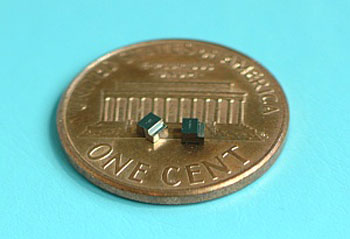| Apr 13, 2011 |
Electromechanical switch using a single magnetic plate delivers superior performance in a tiny package
|
|
(Nanowerk News) Transistors are commonly used in electronics as switches to turn an electrical current on or off. For applications that require a very large ratio between the on and off current, however, it is necessary to use mechanical 'reed' switches, in which magnetic fields physically move metallic wires (or reeds) towards and away from electrical contact points. As devices become more compact, these mechanical switches need to be miniaturized into small packages, without sacrificing performance.
|
|
Min Tang and co-workers at the A*STAR Institute of Microelectronics have now demonstrated a high-performance, ultra-compact version of the mechanical magnetic switch (pictured). Their device consists of a magnetic plate supported by two torsion bars, one on each side ("A Magnetostatic MEMS Switch Designed for Portable Applications"). The plate is made from a soft magnetic material of 80% nickel and 20% iron, and is patterned into long, narrow strips. When a magnet is brought close to the device, the strips align with the direction of the magnetic field, tilting the plate down to establish electrical contact between two gold pads. When the magnetic field is released, the torsion bars tilt the plate back to its original position, breaking the electrical contact with the gold pads.
|
 |
| Two miniature magnetic switches on a US one-cent piece.
|
|
Tang and her co-workers maximized the response of the plate to the magnetic field by choosing appropriate lengths, widths and thicknesses for the strips. This allowed them to use a smaller magnet to actuate the device, which in turn reduced the overall size and power consumption of the switch. The researchers were able to reduce the required magnetic field to 4.8 milliteslas, or about half the field strength required in previous designs. Despite the modest magnetic field strength, they could repeatedly form a reliable electrical connection between the plate and electrical contacs with an on resistance as low as 0.5 ohms and a switching time of close to 2 milliseconds.
|
|
The fabrication requirements for this novel switch are particularly simple because the device consists of a single magnetic plate, whereas previous designs require two. This helps in achieving a small footprint of about four square millimeters. Importantly, the researchers demonstrated that the switch has excellent lifetime characteristics of 34 million switching cycles, and strong shock resistance of greater than 500 g. These characteristics make the switch suitable for a variety of personal electronics applications, including laptops, cellular phones and personal data assistants, as well as medical devices like hearing aids and pacemakers. The researchers' next step is to develop a hermetically sealed package for the switch to support such applications.
|

